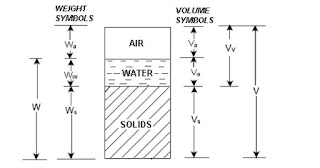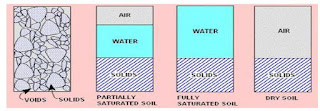Soil Types:
Soils, as they are found in different regions, can be classified into two broad categories:
(1)Residual soils
(2) Transported soils
Residual Soils:
Residual soils are found at the same location where they have been formed. Generally, the depth of residual soils
varies from 5 to 20 m.
The chemical weathering rate is greater in warm, humid regions than in cold, dry regions causing a faster breakdown of rocks. Accumulation of residual soils takes place as the rate of rock decomposition exceeds the rate of erosion or transportation of the weathered material. In humid regions, the presence of surface vegetation reduces the possibility of soil transportation.
As leaching action due to percolating surface water decreases with depth, there is a corresponding decrease in the degree of chemical weathering from the ground surface downwards. This results in a gradual reduction of residual soil formation with depth, until unaltered rock is found.
Residual soils comprise of a wide range of particle sizes, shapes and compositions.
Transported Soils:
Weathered rock materials can be moved from their original site to new locations by one or more of the transportation agencies to form transported soils. Tranported soils are classified based on the mode of transportation and the final
deposition environment.
(a) Soils that are carried and deposited by rivers are called alluvial deposits.
(b) Soils that are deposited by flowing water or surface runoff while entering a lake are called lacustrine deposits alternate layers are formed in different seasons depending on flow rate.
(c) If the deposits are made by rivers in seawater, they are called marine deposits. Marine deposits contain both particulate material brought from the shore as well as organic remnants of marine life forms.
(d) Melting of a glacier causes the deposition of all the materials scoured by it leading to the formation of glacial deposits.
(e) Soil particles carried by wind and subsequently deposited are known as aeolian deposits.
Phase Relations of Soils:
Soil is not a coherent solid material like steel and concrete but is a particulate material. Soils, as they exist in nature, consist of solid particles (mineral grains, rock fragments) with water and air in the voids between the particles. The water and air contents are readily changed by changes in ambient conditions and location.
As the relative proportions of the three phases vary in any soil deposit, it is useful to consider a soil model which will represent these phases distinctly and properly quantify the amount of each phase. A schematic diagram of the three-phase system is shown in terms of weight and volume symbols respectively for soil solids, water, and air. The weight of air can be neglected.
 |
| Phase Relations of Soils |
The soil model is given dimensional values for the solid, water and air components.
Total volume, V = Vs + Vw + Vv
Three-phase System:
Soils can be partially saturated (with both air and water present), or be fully saturated (no air content) or be perfectly
dry (no water content).
In a saturated soil or a dry soil, the three-phase system thus reduces to two phases only, as shown.
 |
| Three-phase System |






No comments:
Post a Comment
If you are getting more information from civilengineerfriend page please give your comments. Share the page information in your whatsapp group. Subscribe our page to get more information.